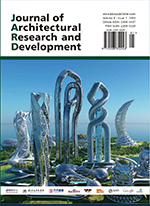Abstract
This paper studies the clan temples in four periods, namely, the development period (early Ming Dynasty and before), the shaping period (mid-Ming Dynasty to early Qing Dynasty), the maturity period (mid-Qing Dynasty), and the programmed period (late Qing Dynasty), analyzes and summarizes their prototypical planform features and attempts to summarize and construct a genealogy of the architectural characteristics of the plane shape of clan temples. During the Ming and Qing dynasties, Guangfu ancestral halls in general showed a journey of development from a centripetal–singlelinear–multi-linear–grid pattern, forming the unique Guangsanlu classic pattern in the Guangfu area.
References
Lai Ying, 2010, Research on Guangfu Ancestral Hall Architecture in the Pearl River Delta, dissertation, South China University of Technology.
National Science and Technology Name Evaluation Committee, 2014, Architectural Terminology, Science Press, Beijing, 91.
Chen J, 2022, Research on Spatial Morphological Characteristics of Guangfu Ancestral Hall in Panyu District Guangzhou, dissertation, Guangzhou University.
Feng J, 2010, Research on the Development of Guangzhou Prefecture in the Ming and Qing Dynasties, the Gathering of Clans, and the Evolution of Clan Ancestral Temple, dissertation, South China University of Technology.
Shi T, Cheng J, 2020, A Trial Analysis of Some Characteristics of Ancestral Halls of the Ming Dynasty in Dongguan. Huazhong Architecture, 38(1): 119–123.
Guo S, 2008, An Analysis of the Aesthetic Characteristics of Lingnan Ancestral Temples. Chinese Ethnic Architecture Research Association, 7.
Feng J, 2006, A Case Study of Fieldwork in Guangfu Villages: Hengkeng. New Architecture, Journal of Statistical Sources, 2006(1): 32–35.
Shi T, 2006, Study on the Residential Architecture of the Guangfu Lineage in Dongguan during the Ming and Qing Dynasties, dissertation, South China University of Technology.
Yang Y, 2013, Research on the Evolution of the Architectural Form of Guangfu Ancestral Hall, dissertation, South China University of Technology.
Liu CW, 1992, Clans and Shatian Development: A Case Study of the He Clan in Shawan, Panyu. Chinese Agricultural History, 1992(4): 34–41.
Liu CW, 1992, Reconstruction of Ancestral Genealogy and Its Significance: A Case Study of a Clan in the Pearl River Delta. Research on Chinese Social and Economic History, 1992(4): 18–30.
Zhang Z, 2013, Research on Lingnan Characteristic Discourse of Traditional Villages in Conghua City, dissertation, South China University of Technology.
Deng K, 2022, Research on the Genealogy of Traditional Residences in Guangzhou Under the Perspective of Architectural Typology, dissertation, South China University of Technology.
Hu X, 2016, Preliminary Exploration of Shunde Ancestral Hall Architecture - Taking the Huang Family Ancestral Hall on the Right Beach of Xingtan as an Example. Modern Decoration, 2016(8): 224–225.
Guo S, 2007, Survey and Research of Cao’s Great Ancestral Temple in Caobian Village, Nanhai, Guangdong Province. Proceedings of the Fifteenth Chinese Folk Habitat Conference, 4.
Lai Y, 2008, Maintenance Design of Mo’s Ancestral Hall in Xinji. Ancient Architecture and Garden Technology, 2008(1): 30–34 + 68.
Peng Y, 2016, The Construction and Development of a Two-Surname Clan Village by the Pearl River-Reading Lijiao from the Weihuetang Tuzhi. Southern Architecture, 2016(3): 46–51.
Wang C, 2010, Regional Characteristics of Lingnan Architecture from the Architecture of Late Qing Clan Ancestral Halls. Journal of Fine Arts, 2010(2): 52–56.
Yan Z, 1987, Guangdong Kaiping Style Hall, Central China Architecture, 1987(2): 78–82.
